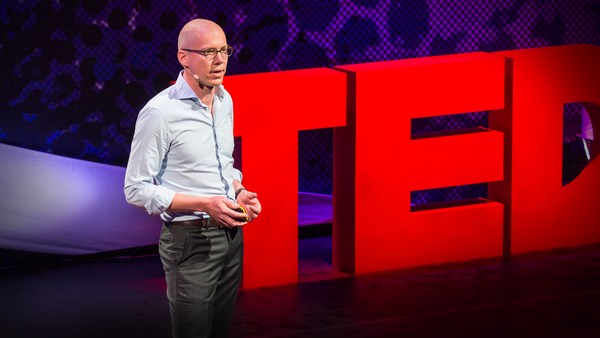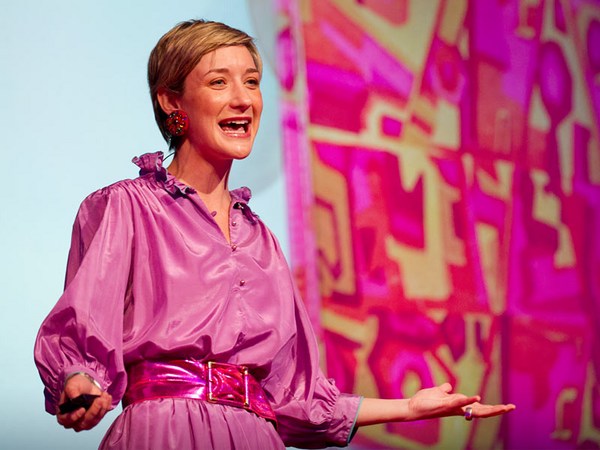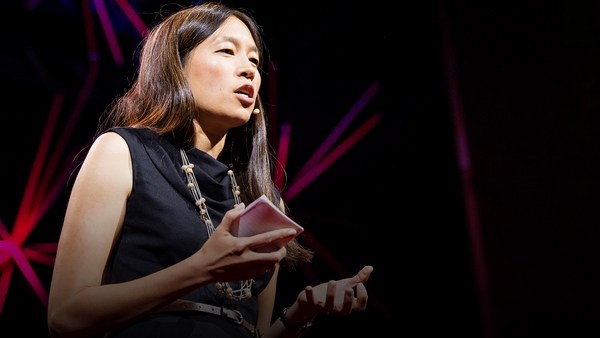OK, stand up, please, if you're wearing clothes. Simple request. Off you pop. OK. I can't see at the back, but it looks like there're no naked people here today. (Laughter) Now, I ask you, please, to remain standing if you feel completely happy about every item of clothing you are wearing today. Where it has come from, the conditions under which it has been made, who has made it for you. OK. OK. Well, congratulations to this very small spattering of people still standing. But for most of us - You can sit down now. Most of us, we are not loving the clothes we are wearing, and I'm not at all surprised because frankly, fashion has become a pretty murky world. But it didn't start that way. You know, until very recently, it had everything to be proud of and nothing to be ashamed of. It began with sustainable, natural materials that were woven and sewn locally, with care. We cherished our clothes. We repaired them. We passed them on. Eventually, they were recycled. Our need for clothing drove an entire industrial revolution. Adam Smith said that Industrialisation would enrich us all in a positive cycle of employment, consumption, profit, and more employment. In the developed nations, we got busy making things. We made all sorts of stuff. We made clothes, of course. But we also made washing machines. We made cars. We made healthy soap, whatever that might be. (Laughter) You know, this work created prosperity for millions of people. In the early 19th and 20th century - sorry, in the 19th and early 20th century, almost everything we used every day was made locally. But as the 20th century progressed, local capitalism became global capitalism; industrialisation became globalisation. And local clothing businesses that cared about people and products gave way to global fashion businesses that were driven by share price and profit. Factories in the developed world closed in their thousands. Millions of people lost their jobs, and the entire manufacturing regions were simply left to rust. But I believe that manufacture of clothing and other everyday items actually has a future in the developed world. I believe that manufacturing jobs have a vital role to play in restoring prosperity to some of our poorer communities. So, allow me to give you a potted history of the clothes we wear or don't wear. It started around about 30,000 BC. We know this weirdly because of fleas. There I am; I am naked, obviously, and a bit chilly. So, what I do is I skin an animal that I have just eaten. I use a bit of gut, and a needle that I whittled from some bone. And hey, presto, I have invented clothes. And don't I look pleased and beardy? (Laughter) By 1 AD, we have mastered the art of spinning and weaving and dyeing. By the 1500s, a busy merchant class organized the financing and production of cloths, which still is a cottage industry, really, often made by farm workers in the quiet periods in the agricultural calendar. Drapers, tailors, and dressmakers served the wealthy, but for most of us, clothes are bought second, third or even sometimes fourth-hand. Leaping forward again, through the 1850s, it's the end of the first industrial revolution. At this point, we have powered weaving and spinning, we have invented the sewing machine and the factory system. All of this innovation radically cuts the cost of clothing and improves its quality. This is the birth of consumer fashion. Retailers and department stores sell ready-to-wear clothes, and for the first time, new clothes are broadly available, and they are affordable. Lancashire has become the biggest textile producing region in the entire world. Now in the early 1800s, UK mills were grim, unsanitary, and frankly, dangerous places. Men, women, and children worked long hours for miserable pay. And we, the British public, were frankly and rightly outraged. New laws were introduced, which forced factory owners to clean up their act. But Adam Smith was right. Regular consumption led to regular employment, and wages flowed into the local economy, raising everybody's living standards. And crucially, the profits from all of this enterprise stayed local too. In 1850, 80% of Lancashire mill owners were born in Lancashire. They spent their money locally. And the profits from all of this textile industry allowed them to build grand civic buildings. They built hospitals and schools and magnificent parks. And at the same time, a new breed of paternalist mill owners built extraordinary model communities around their factories. They built libraries and lecture theatres and cooperative stores and social and sporting clubs and bath houses. These were utopian working communities like Robert Owen's New Lanark in Ayrshire or Barrow Bridge near Bolton. These enlightened, progressive employers understood that healthy and happy workers were productive workers. Right. Leaping forward. There I am. You recognise me on the left. This is the 1970s, the age of man-made fibre. But this is a period in which the textile and clothing industries went through an enormous period of consolidation. Gone are the local business owners; instead, we have shareholders who demand profit, and they demand growth. This is the year in which fast fashion first appears. You may not believe that, but it was a long time ago. And of course, this leads to a dramatic drop in price, but also in quality. All of a sudden, driven by cheap labour and cheap materials, the labels in our clothes read "Made in Hong Kong", and "Keep away from flame". Now, where are we today? Well, the Internet, social media, and smart phones have absolutely transformed the fashion industry once again. A new wave of online fashion businesses have driven another dramatic drop in prices and quality. A dress used to cost a week's wages and would've been worn for years. Today, you can buy a dress for less than half an hour's pay. You and I can look like Kylie Jenner for less than a tenner. (Laughter) But all of this comes at a pretty high price. You know, cheap fashion doesn't come for nothing. Fashion has become the world's second biggest polluter. A new clothing is now so cheap that it is no longer worth recycling. In the 15 minutes, it takes me to deliver this talk to you today, a million kilos of clothing will be sent to landfill, half of it plastic. Today the manufacturer of clothing employs about 66 million people, most of them in Asia, where there are many fantastic factories. But these factories are too expensive for fashion's new wave. Instead, production is moving to grim, unsanitary, dangerous - does it sound familiar? - factories in places like Cambodia and Bangladesh and India and Vietnam. I urge you, if you don't already know about it, to Google "Rana Plaza". Watch a movie called "The True Cost". Watch "Machines" by Rahul Jain. See for yourself the price of all this cheap fashion. So, what about our manufacturing regions? Well, at the peak, in the UK, there were around 1.6 million people employed making textiles and clothing. Today, there are fewer than 50,000. In the USA, around about two million people have lost their jobs. The world might well be getting richer, but for these regions, they're feeling nothing but poorer. So, is that it? Well, in the UK, we spent 56 billion pounds on clothing last year. But only 2% of it was made here. We pretty much gave up on large-scale clothing manufacturing in the 1990s, but a great deal has changed since then. Recent research suggests that 70% of us claim, at least, to care about supporting local manufacturing jobs, which is a big change. And manufacturing technology has moved on again, changing the economics of production. In theory, a state-of-the-art clothing factory can manufacture a T-shirt in four minutes. Now, even in the UK, that is less than a pound's worth of labour. It is perfectly possible for UK clothing factories to compete with China on price. I know this, because in 2015 I bought a struggling clothing manufacturer in Blackburn in Lancashire. And you won't be surprised to know I did some sums. (Laughter) But in practice, my factory was stuck in a spiral of declining investment and declining efficiency. But I had an idea about how you might reverse that cycle. And in 2016, I started a manufacturer's co-operative I called Community Clothing. We do two pretty simple and quite obvious things. The fashion industry uses a model that was developed during the 20th century, essentially to drive your consumption and to maximise share-holders' profit. This is what it looks like. Just 25% of the price you pay - and that's frankly being generous - goes on making your clothes. The other 75% is all of the apparatus of consumption. So the first thing we do in Community Clothing is we get rid of that 75%. No advertising, no seasonal re-designs, no retail, no free stuff for celebrities. (Laughter) They get enough. (Laughter) This shows you what the demand on a typical UK clothing factory looks like. So, it's full here, when making fashion seasonal collections, but it's absolutely quiet in-between. All of that spare capacity absolutely cripples factory efficiency. So, the second thing we do at Community Clothing is we make all of our products in that quiet period. We make great quality, affordable, everyday clothes today in about dozen UK factories. Our aim is to fill these factories year-round, and by doing so, create a positive cycle of rising efficiency, rising investment, and job creation. So far, we've created about 11,000 hours of skilled manufacturing work in the UK, which is a decent start, but our goal is to create at least 5,000 permanent jobs. The future of work will look nothing like it does today. A new era of automation and AI will change the face of work entirely. Some estimates suggest that close to half of all jobs are at risk. So, if automation is going to make cheap labour at minuscule factory in all of this, why make stuff on the other side of the world? You know, we cannot go back to the industrial economy of our past. But why not make these things here, in small, nimble factories? I visit a lot of factories. I love a factory. This one is Rolls Royce near Goodwood. Frankly, it's so cool I'd like to live in it. (Laughter) This one is Jaguar Landlover in Solihull. Also, very very sexy. These are extraordinary workplaces. These are fantastic employers. I hear the pride in the voices of every man and woman who works in these places. The town of Blackburn, where I spend a lot of time, has a motto. That motto is "Arte et Labore", "by skill and hard work". I would like Blackburn and towns like it to have a future based on skilled manufacturing work. I would love young people growing up in the region to dream about working in factories. (Laughter) Now, imagine if you ask yourself the question, "Do I feel happy about the clothes I'm wearing?" Instead of thinking about landfill and polyester and cheap labour, you could think to yourself, "I'm wearing a wonderful garment created by the skill and hard work of folk like this wonderful lot, men and women whose prosperity and well-being is tied to our prosperity and well-being, men and women from my community." Instead of simply being a consumer, why not be a participant in something of genuine value, something that makes you feel proud? Do you feel happy? Well, that's up to you. The answer could be an unequivocal "yes". Thank you. (Applause)
Related talks

Olivier Scalabre: The next manufacturing revolution is here

Robert Neuwirth: The power of the informal economy

Jessi Arrington: Wearing nothing new

Amit Kalra: 3 creative ways to fix fashion's waste problem

Johanna Blakley: Lessons from fashion's free culture
